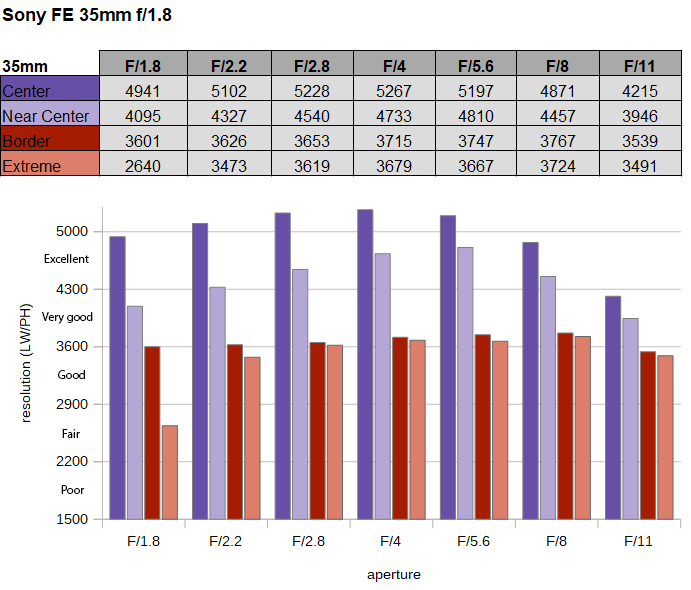|
Sony FE 35mm f/1.8 - Review / Test Report - Analysis |
|
Lens Reviews -
Sony Alpha (Full Format)
|
|
Page 2 of 3

Distortion
The Sony FE 35mm f/1.8 is well-corrected. Uncorrected images show a pincushion distortion of merely 0.3%. This is already negligible. Image auto-correct can, of course, reduce this easily down to 0%.
Vignetting
The vignetting characteristic is very unusual albeit not totally unique.
Uncorrected images show a heavy light falloff of more than 3EV (f-stops) at f/1.8. This alone is nothing special. Many ultra-large aperture lenses produce similar figures at a fully open aperture. However, stopping down results in an almost linear decrease along with the aperture range and there isn't much of an improvement. The vignetting is still heavy at f/5.6.
Consequently, it is a good idea to keep image auto-correction activated. This improves the issue by about 1.5EV (f-stop). This remaining vignetting is still noticeable but acceptable.

MTF (resolution)
Some weirdness continues on the resolution side. The center performance is stunning even at f/1.8 and the near-center performance is at least very good. The borders are also quite sharp whereas the corners are soft. Stopping down to f/2.2 results in a slight quality increase in the broader center zone and the corners are catching up to good levels. Stopping down further barely improves the outer image field which is somewhat puzzling. There is still some gain in center quality which reaches its peak around f/4. Diffraction has a higher impact at f/11 albeit mostly in the center zone.
The centering quality of the tested sample was good. Field curvature is not an issue.
Please note that the MTF results are not directly comparable across the different systems!
Below is a simplified summary of the formal findings. The chart shows line widths per picture height (LW/PH) which can be taken as a measure for sharpness.
If you want to know more about the MTF50 figures you may check out the corresponding Imatest Explanations

Chromatic Aberrations (CAs)
Lateral CAs are clearly on the high side for a modern prime lens. The issue increases from an average pixel width of 1.3px at the image borders at f/1.8 to beyond 2.5px at medium aperture settings. The high CAs probably relate to the fact that this lens doesn't feature UD elements.
That being said, lateral CAs can be eliminated via auto-correction without a loss in image quality so it's not really an important aspect anymore.

Bokeh
If you decide to buy a fast prime lens, you tend to do it for shallow depth-of-field photography thus the quality of the out-of-focus blur is a major criterion.
Let's have a look at the out-of-focus highlight rendition first. As you can see below, the inner zone of the highlight discs is very clean and there's a quite smooth transition at the edges of the discs. There is just a tiny bit of an outlining effect. Stopping down maintains the circular shape (near the image center) until f/2.8.
 The image center is the easy part but what about the outer image region? At f/1.8 the shape is ellipsoid which is more pleasing than the usual "cat eyes". The corner highlights do show some outlining effect though. Stopping down improves the shape of the discs in the broader center but the corner discs are becoming a bit edgier.
The general out-of-focus rendition is very smooth in the image background (shown to the left below) whereas the usually less critical foreground can show more distinct double edges (to the right).
The image center is the easy part but what about the outer image region? At f/1.8 the shape is ellipsoid which is more pleasing than the usual "cat eyes". The corner highlights do show some outlining effect though. Stopping down improves the shape of the discs in the broader center but the corner discs are becoming a bit edgier.
The general out-of-focus rendition is very smooth in the image background (shown to the left below) whereas the usually less critical foreground can show more distinct double edges (to the right).

Bokeh Fringing (LoCA)
Bokeh fringing, sometimes called LoCA or axial CAs, is a color fringing effect on the Z-axis with a purplish tint in the foreground of the in-focus zone and greenish beyond. APO lenses correct this issue but the Sony FE 35mm f/1.8 is not among them as you can see below. The effect is very noticeable at f/1.8 and decreases only slowly when stopping down. The fringing is mostly gone from f/4 onward.
|